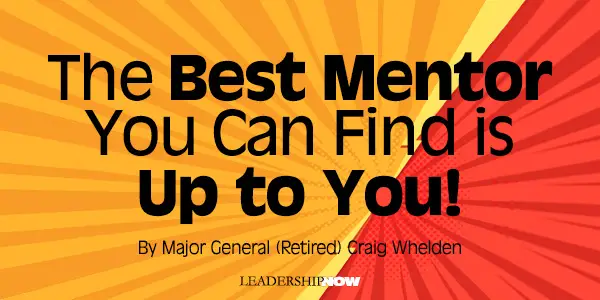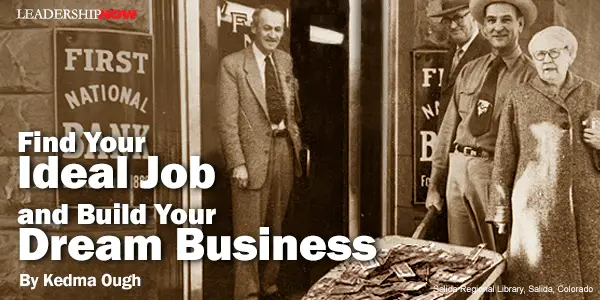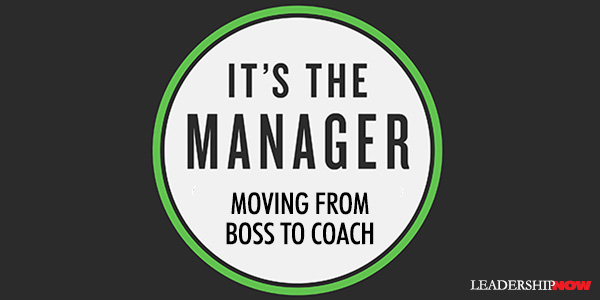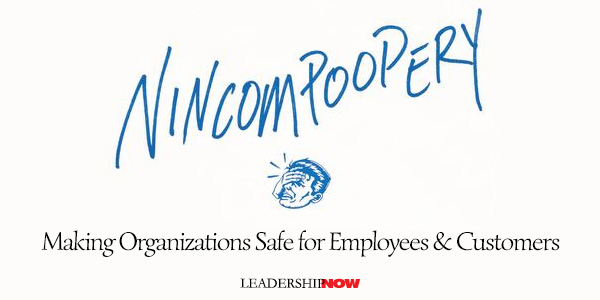 Leading Blog | Posts by Month |
 Leading Blog | Posts by Month |
08.31.19

LeadershipNow 140: August 2019 Compilation
See more on
Posted by Michael McKinney at 06:49 AM
08.28.19

The Best Mentor You Can Find is Up to You!
“The greatest good you can do for another is not just to share your riches but to reveal to him his own.” WHEN I WAS a young Army lieutenant, I met with my Assignment (Personnel) Officer, Major Tom Montgomery in Washington D.C. on my way to Germany in the summer of 1977. I never expected that he would become my first true mentor. There was no contractual agreement or even a discussion about such a relationship, and through all these years, I’ve never mentioned the word “mentor” to him. But, throughout our relationship, our conversations have given me volumes of knowledge about leadership and a host of other topics. I saw in him a leadership style similar to my own, just more seasoned. I wanted to learn as much as I could from him and use similar techniques as my own leadership responsibilities grew. He helped me get certain jobs and I worked directly for him once. We remain great friends to this day. Receiving mentorship is a vital element in learning about leadership… and being a mentor is a responsibility of all great leaders. I believe there are four types of mentors: assigned, self-appointed, sought-after, and what I call “virtual.” I have experienced all four. The first three are rather self-evident in terms of what they mean. What I’ve found the most valuable, however, is this last one, virtual. What do I mean? Virtual mentorship is something you do on your own. You simply pay attention to all of the people around you and learn from them. This can apply to both your professional and personal life. Pay attention to what others do or say that is particularly smart or good, then adopt it as your own habit. Notice also when a leader does something incredibly dumb or harmful to others, then put that in your leadership reservoir as well, so that you will never do the same. We’ve all seen good and bad behavior and said to ourselves: “If I ever get into that position, I hope I behave—or do not behave—like that.” Think of your life as a journey carrying a backpack, and observed behaviors are rocks you find along the path. Pick up both the good and bad—the good for future use and the bad to remind you not to repeat what those rocks represent. I’ve got plenty of rocks in my backpack—of both kinds—that I’ve picked up along my life’s journey. All great leaders learn something from those they encounter along their journey. It’s also a good practice to acknowledge those who provided meaningful lessons. I regularly cite those who taught me something that I now use myself. I also store away lessons that I want to avoid from leaders who I don’t want to emulate, though I generally refrain from naming them. Perhaps one of the greatest periods during which I learned from others was my time in the Pentagon in the late 1990s. My 23 years of service to that point had been exclusively within Army ranks, with no duty served in another military branch. But in 1996, when I became a new brigadier general, I was assigned to the Joint Staff in the Pentagon. I served during this time with a number of great military leaders who influenced me. Lieutenant General Pete Pace (later Chairman of the Joint Chiefs of Staff) was the J3 of the Joint Staff. I had to brief him each morning. My immediate supervisor was first Major General John Van Alstyne, then later Rear Admiral Tim Keating (who eventually became the Pacific Command Commander and Northern Command Commander as a 4-star admiral). Brigadier General Jim Conway (later Commandant of the Marine Corps) was a fellow 1-star and Colonel David Petraeus was the Executive Officer for the Chairman of the Joint Chiefs of Staff, General Hugh Shelton. Lieutenant Colonel Terry “Guts” Robling served there as well and would later become my boss as a three-star general when he commanded Marine Corps Forces Pacific and I was his civilian Executive Director. That was a particularly interesting relationship, as he was a lieutenant colonel when I was a brigadier general in 1996. While he didn’t report to me, we knew each other and occasionally worked together. Seventeen years later, I reported to him. I remember our first discussion in his office in 2013, where I made clear that while we had a different relationship in the Pentagon, I was perfectly fine working for him. I remember him saying he was, as well. He was very comfortable in his own skin. We got along great in the two years of his command tenure and remain good friends to this day. Good leaders don’t patent their behaviors; they willingly pass them on. I have borrowed many leadership techniques—perhaps most of them—from others who freely gave them up, and from some who didn’t even know I took them. Let your greatest legacy be that you pass on the best-of-breed leadership traits you’ve learned from others. I freely pass on mine. Many are in my new book, Leadership: The Art of Inspiring People to Be Their Best.  
Posted by Michael McKinney at 10:13 PM
08.22.19

Building Company Culture: Alignment Leadership
YOU PROBABLY HEAR the word culture a lot, but what does it mean? We’ll discuss it here but I can definitively tell you this: Without a strong company culture, you can’t create a fulfilling environment for your employees. In fact, the whole idea of culture is a moving target. Yes, it’s widely discussed, but somewhere between the discussion and the implementation something happens. Oftentimes that something is the watering down of the whole idea in the first place and casting it off as a soft science that doesn’t really impact the bottom line. Nothing could be further from the truth. What Is Culture? So, let’s begin at the beginning. What is culture? My definition of culture is the sum of a group of people’s beliefs, traditions, preferences, experiences, and hopes. Any time you put people together, a culture is created. Whether or not you agree with the traits of each person’s worldview—their beliefs, traditions, preferences, experiences, or hopes—that worldview exists. Every person has their own unique worldview, and the way they see the world combines with others to create the culture of that group. The individual traits of a person affect how they view the world and interact with others. For example, the word “trust” means one thing to one person and something different to another person, based on their experiences. The various meanings of trust within a group define their culture around that word. Imagine if a group of ten people working together had vastly different impressions of trust. What kind of culture would that create? Somebody has to clearly define it so that everyone knows what the end game is and how to achieve it. And take note that this is just one word and one idea that can be misconstrued. How many others are there that we assume there is agreement on? Don’t assume. Define. Create a common language and an agreed upon taxonomy that there is no doubt about. Get this right and your organization wins. Misconceptions about Culture Culture cannot be developed by simply creating environments where people congregate together. You’ve been at those events, right? Sometimes it’s a movie night or a day out on a boat or a team building exercise. These are usually great fun and they give us a chance to get to know each other away from the office. But, truthfully, this is just one step in creating a defined company culture. In my journey of leadership, this is a concept I fell prey to early on. In an effort to improve employee engagement, I created happy hours, pizza Fridays, and a party planning committee. What I didn’t realize was that without the initial investment in people before creating these events that fostered community, the experience would be a shallow attempt at culture. Alignment Leadership requires an intimate pursuit of employees, and this pursuit will never happen at a happy hour or a five-minute interaction while sharing a slice of pepperoni. As I began to develop this theory of Alignment Leadership, I realized the real win was much deeper—employee fulfillment. A happy hour can actually be an icebreaker to introduce someone into a community and build a deeper relationship. We go into these opportunities with the intention to further discover our employees, which leads to alignment. You want to develop a culture where you’re able to authentically allow your employees to be known, heard, and valued. Where to Start Creating a culture starts with conversations between you and your people to clearly define the culture you have—and the one you want to build together. You need to have conversations that clarify the culture of your team, the culture of your department, and the culture of the company. This needs to be perfectly understood both from the leader’s perspective and the employees’ perspective. Creating a culture won’t happen overnight. People’s worldviews are deeply rooted in who they are, and combining them into a culture that works for everyone will require people to make changes. It may take several years, but if you put in the effort to lead your team and work together, you can develop an authentic, meaningful company culture. 
Posted by Michael McKinney at 09:44 PM
08.20.19

Find Your Ideal Job and Build Your Dream Business
IS IT POSSIBLE to have your cake and eat it too? If there was a way to find your ideal job and build your dream business, would you consider both? Most people see this dichotomy and feel that they need to choose one dream over the other. The reality is that you can have both dreams so long as each doesn’t harm the other and enhances your lifestyle. Having worked with more than 10,000 entrepreneurs, innovators, inventors, hobbyists and side hustlers, they often struggle with when it is appropriate to leap from the job environment into the entrepreneurship maze. The presumption is that one has to sacrifice entrepreneurial dreams in order to be successful at a specific career choice. The truth is that you can have both and I strongly encourage aspiring employee-preneurs to review the following five reasons to consider maintaining your job in the first few years of building your business. 1. Learning from Both Work Environments: When you work as an employee and have a side entrepreneurial business, you can learn from both environments and both environments can benefit from each other. Often the entrepreneurial pathway is a lonely pathway and sole-preneurs in particular find themselves trying to navigate, learn and network to gain knowledge while building their business. Realizing that you can gain education from both environments allows an opportunity for you to thrive as an employee and manage a successful side hustle. 2. Business Ownership Strengthens Your Employee Net Worth: In most positions you rarely get the opportunity to experience the functions associated with the roles of a Chief Executive Officer, Chief Financial Officer, and Chief Marketing Officer, as well as manage the day-to-day requirements for customer engagement and retention. As a result of limited job functions in a large corporate environment, it doesn’t give you the full breadth of work involved in successfully managing an enterprise. By exploring the entrepreneurship maze you will quickly immerse yourself in all these functions, which will give you a better picture of the business itself, as well as an appreciation for the company that employees you. 3. Position Yourself with a Better Financial Portfolio: Quitting your job and then applying for a small business loan is a recipe for disaster. Often lenders expect borrowers to be fully collateralized. Having a successful employment position strengthens your probability of obtaining a loan or line of credit. While there are a lot of targeted small business funds that don’t require full collateralization, obtaining funds from your financial institution will be challenging if your debt to equity ratio does not meet their criteria and you don’t have a secondary source of income they can secure against the loan. In addition, being employed allows you the flexibility of investing in your small business without the stress of adding more debt into your current financial portfolio. Having the availability to set aside a few hundred dollars each month towards your business is significant when you have to consider paying for licensing, website development, social media support, etc. 4. Don’t Put Your Financial Eggs in One Basket: Diversifying your income allows you to mitigate financial risk and maximize your ability to make more money. Most people rely on their employment position for sole source income and if that position is compromised they may have a difficult time replacing those funds in a short period of time. Creating other opportunities to generate more money provides an additional financial cushion for investments or as an emergency fund program. The key is to target business concepts that don’t impose too much time on your part but produce a sizable financial return on your investment. Examples may include selling products online, starting a consulting business, or purchasing a semi-absentee franchise opportunity. 5. There Is No Need to Rush the Process: Most entrepreneurs believe they have to rush things to launch a company because they may lose out on the business opportunity. This may actually be a recipe for disaster. Rushing into a business concept without a proper feasibility review including competitive research, market analysis, and customer input is rushing to an unproven plan. Spending time building the foundation of the business allows for validation and a chance to identify the strengths, weakness, opportunities and threats of the proposed concept. Once the business has reached a certain consistent income you can decide whether to leap into the business full-time or hire others to manage the business. Ironically many of the Fortune 500 companies today began with entrepreneurs that started their business concept while working for an employer and then transitioned to their business slowly. Skin in the game does not mean you have to quit a job to explore a business. It means you have to be willing to invest time, money, or both in order to build your side hustle into a fledging small business operation. The great news is you don’t have to sacrifice either opportunity to benefit from both opportunities. You can have your cake and eat it too.  
Posted by Michael McKinney at 05:33 PM
08.14.19

It’s the Manager: Moving from Boss to Coach
NOT SURPRISINGLY, a Gallup World Poll found that the great global dream is to have a good job with mission, purpose, and at a living wage. But the vast majority—85%—hate their jobs. If you couple that fact with George Gallup’s “single most profound, distinct and clarifying finding ever” that 70% of the variance in team engagement is determined solely by the manager, then the issue becomes the manager. That being the case, the single key to maximizing human potential and organizational growth is to improve the quality of the manager. The most important person in your organization to bring teams together and lead them to great decisions is the manager. Jim Clifton and Jim Harter of Gallup explain how to build a strengths-based culture that attracts the best employees and maximizes their potential in It’s the Manager. They cover five major topic areas—Strategy, Culture, Employment Brand, Boss to Coach, and Future of Work—an offer 52 discoveries from Gallup’s largest study of the future of work. The most important sections for me are Employment Brand and Boss to Coach. The practice of management has been stuck in time for more than 30 years, despite the world and workplace going through extraordinary historical change. “The problem is, while the science of management has advanced significantly in the past three decades, the practice of management hasn’t.” In the new working environment, one of the biggest challenges is for managers to go from boss to coach. The old boss-to-employee, command-and-control leadership environment has “worked” when it comes to building process-efficiency systems, engineering large buildings, and creating infrastructure. But the top-down leadership techniques of the past have not adapted to a workplace that now demands coaching and collaboration to thrive. However, I would argue that top-down and coaching and collaboration are not necessarily mutually exclusive. That said, coaching requires three things: establish expectations, continually coach, and create accountability. Their research has found that “employees whose manager involved them in setting goals were nearly four times more likely to be engaged than other employees” and those who receive “daily feedback from their manager are three timed more likely to be engaged than those who receive feedback once a year or less.” Gallup analytics finds that most current team leaders do not have the natural tendencies for managing people. We often promote people for the wrong reasons like success in a prior non-management role and tenure. Organizations still think largely in terms of promoting up the corporate ladder when other options exist like changing teams, projects, or even managers. Unfortunately, many organizations still offer only one way “up”: Become a manager, even if your strengths aren’t in management. Some people who aren’t really cut out to be managers may do an OK job, but they never feel quite right managing. And this affects their wellbeing—and the wellbeing of those they manage. Gallup research fronds that great managers have these five traits: Motivation (inspiring teams to get exceptional work done), Workstyle (setting goals and arranging resources for the team to excel), Initiation (influencing others to act; pushing through adversity and resistance), Collaboration (building committed teams with deep roots), and Thought Process (taking an analytical approach to strategy and decision-making). There is a code to take the CliftonStrengths assessment and an appendix section that provides guidance for leading with each of the 34 strengths. (As a side note, I found this statistic enlightening: “Your employees are grumbling, as 50% of them are making less than they were 35 years ago. In real terms—overall—your employees have not received a raise in more than 35 years. Their expenses of housing, healthcare, and education are exploding while paycheck sizes are frozen or declining.”) 
Posted by Michael McKinney at 10:18 AM
08.08.19

Nincompoopery: Making Organizations Safe for Employees & Customers
NINCOMPOOPERY is the crazy stuff we do (or don’t do) that drives our customers crazy and makes life difficult for employees and keeps organizations from getting what they want. There are nincompoops, and there is nincompoopery. But when an organization is driving people crazy, it’s a nincompoopery problem. Usually, the organization knows what’s wrong; it’s just that nobody has the courage to overcome the tradition, the inertia, or the apathy to fix it. And so, it persists. John Brandt writes in Nincompoopery: Why Customers Hate You—and How to Fix It, that the good news is that there is a plan to fix it and you already know enough to get started. Most organizations are rife with Nincompoopery, which deadens the souls of their employees (including, sometimes you and me) and lead them (us) to act like nincompoops. To wit, we get stuck in old ways of doing things; we convince ourselves that change would be impossible because nobody could fix such a nincompoopish company anyway; or we fret that even if we tried to lead a change, none of the nincompoops to whom we report or work with would listen. Really, human beings are endlessly inventive in thinking of reasons why not to change ourselves, our companies, and our fates—in other words, we’re really good at remaining nitwits and stuck in Nincompoopery. So, you need a plan and some good politics by managing relationships, providing safety and meaning in order to make the changes out of nincompoopery. Brandt offers a plan organized around three simple strategies: innovation, talent, and process. Innovation Innovation is not always the game-changing products that change a culture. Customers think differently about value. Innovation should revolve around “How can we make our customers’ lives simpler, happier, less stressed, and more productive, by removing or solving multiple issues with a single solution?” Talent “Leading companies recruit for smarts, diligence, and caring.” Character matters. “The only way that we create a difference at any individual customer’s moment of truth is by the investment we make in talent, training, and culture. That difference, for good or bad, will determine our bottom lines for years to come. If you hire right, train right and get out of their way, your employees will deliver. Process With god process in place, you can reap the benefits of the time, effort, and money you’ve invested in innovation and talent. Look at your company through your customer’s eyes. How do you create customer value? What are you good at, and what are you terrible at? Your customers know. Brandt says excel, improve, and fix—or kill. Start with what you are terrible at and fix it or kill it because it is driving customers away. With a little bit of strategic thinking and a whole bunch of empathy for customers and employees, you can lead change and eliminate nincompoopery. 
Posted by Michael McKinney at 04:58 PM
08.01.19

First Look: Leadership Books for August 2019Here's a look at some of the best leadership books to be released in August 2019. Don't miss out on other great new and future releases.
Transforming Legacy Organizations provides real-world advice and research-based information on how to grow innovation by employing new technologies, improving processes, and establishing a culture of creativity and forward momentum. Conventional business wisdom views innovation as the biggest advantage startups have over large, established organizations, often referred to as legacy organizations. This belief is false, especially when considering that 70% of all startups fail within 20 months of their first venture round. The truth is innovation initiatives of legacy organizations have far better chances of succeeding.
In these tumultuous times of economic and technological change, staying ahead depends on continual self-education—a lifelong mastery of fresh ideas, subjects, and skills. If you want to accomplish more and stand apart from everyone else, you need to become an ultralearner. The challenge of learning new skills is that you think you already know how best to learn, as you did as a student, so you rerun old routines and old ways of solving problems. To counter that, Ultralearning offers powerful strategies to break you out of those mental ruts and introduces new training methods to help you push through to higher levels of retention.
Everyone has insecurities. Like with most insecurities–especially those that are not self-inflicted–we don’t tend to “fix” or “get over” them; they are always with us and a part of who we are. However, if we are honest with ourselves, we can recognize them, understand them, and seek to find a way to live our most authentic lives free from the chaos they often create.
Oren is throwing out the old playbook on persuasion. Instead, he'll show you a new approach that works on this simple insight: Everyone trusts their own ideas. If, rather than pushing your idea on your buyer, you can guide them to discover it on their own, they'll believe it, trust it, and get excited about it. Then they'll buy in and feel good about the chance to work with you. That might sound easier said than done, but Oren has taught thousands of people how to do it with a series of simple steps that anyone can follow in any situation. And Oren has been in a lot of different situations.
Instant gratification is the norm today—in our lives, our culture, our economy, and our politics. Many of us have forgotten (if we ever learned) how to make smart decisions for the long run. Whether it comes to our finances, our health, our communities, or our planet, it’s easy to avoid thinking ahead. The consequences of this immediacy are stark: Superbugs spawned by the overuse of antibiotics endanger our health. Companies that fail to invest stagnate and fall behind. Hurricanes and wildfires turn deadly for communities that could have taken more precaution. Today more than ever, all of us need to know how we can make better long-term decisions in our lives, businesses, and society. Bina Venkataraman sees the way forward.
 Build your leadership library with these specials on over 39 titles. All titles are at least 40% off the list price and are available only in limited quantities. “If we encounter a man of rare intellect, we should ask him what books he reads.” — Ralph Waldo Emerson
Posted by Michael McKinney at 09:11 AM
|
BUILD YOUR KNOWLEDGE


How to Do Your Start-Up Right STRAIGHT TALK FOR START-UPS 
Grow Your Leadership Skills NEW AND UPCOMING LEADERSHIP BOOKS 
Leadership Minute BITE-SIZE CONCEPTS YOU CAN CHEW ON 
Classic Leadership Books BOOKS TO READ BEFORE YOU LEAD |
|